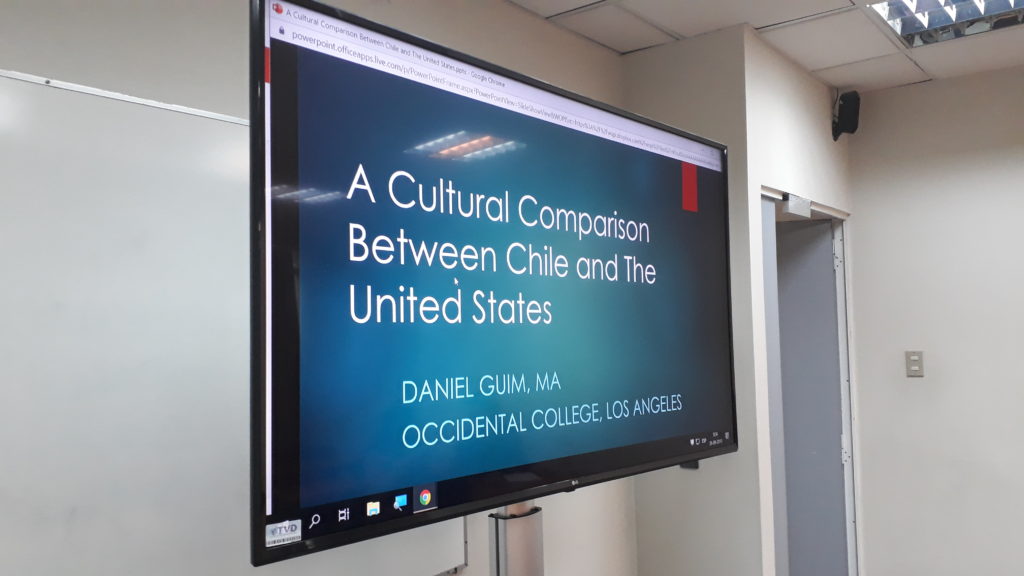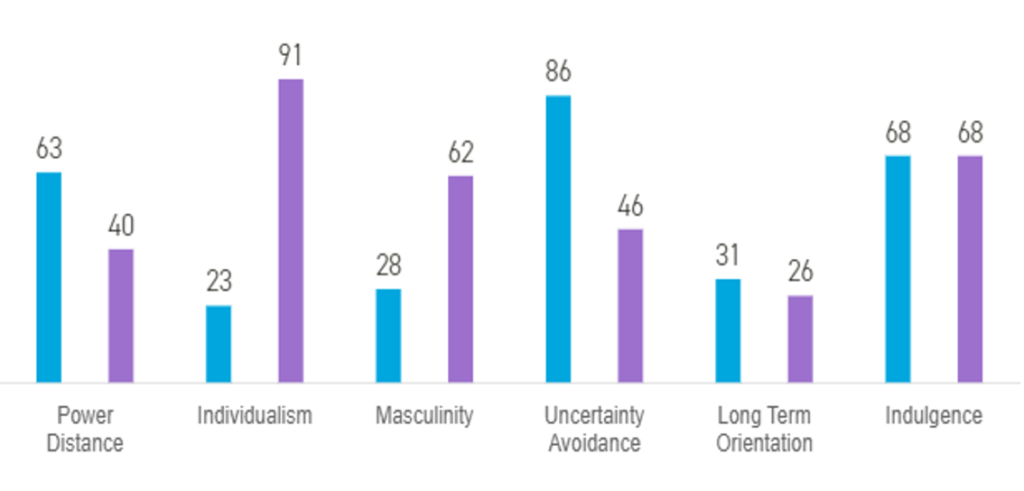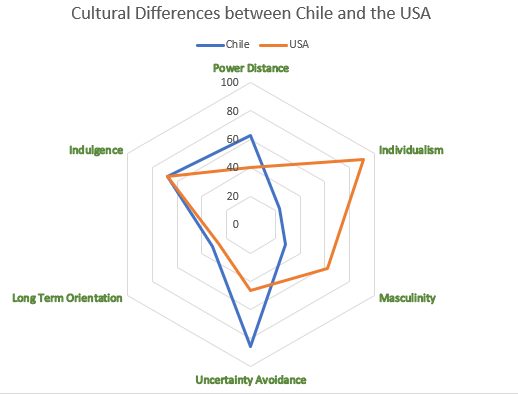Earlier today I had the privilege to give a presentation to English pedagogy students at Universidad Mayor. My friend and colleague José Luis Poblete talked to me about the opportunity last month, and I’m really glad I took him up on the offer.

A while ago I found a really useful website that provides a summary of the culture of different countries based on extensive research. It’s called Hofstede Insights, and it’s based on the work of Geert Hofstede. It uses a 6-dimensional model with the following elements: power distance, individualism, masculinity, uncertainty avoidance, long term orientation, and indulgence. For each of these 6 dimensions, each country is given a rating of 1 to 100. If you’d like to visit the website, you can click here.
Before I share the ratings for Chile and the United States, there are a few things to keep in mind:
- I was unable to find out the date when this research was done, and I do not know how often it is updated. As a result, it is possible that attitudes are changing and that these scores will adjust over time.
- The website gives a summary for each dimension for each country, but that does not mean that what it says is true for every single person of a culture.
- This is based on my impressions from having lived in Chile for almost a decade. I am certainly no expert on Chilean culture, so my ideas can be taken with a grain of salt.
- It’s okay if you do not agree with everything that the website says. In fact, discussing the ratings with the students led to some really interesting discussions about how Chile is changing.
Here is a brief summary of each of the areas and the ratings.
Power Distance
According to their research, power distance is “the extent to which the less powerful members of institutions and organizations within a country expect and accept that power is distributed unequally.”
When I think of a country with a high rating of power distance, I think of workplaces with a well-defined hierarchy, clearly defined roles and no real opportunity to question authority. The lower the rating, the more I think of people in different positions at a job seeing themselves as more equal.
For Chile, its power distance score is 63, and for the USA it is 40. This tells us that in general there is more fluidity and equality between workers and their superiors in the USA; in Chile there is more inequality in terms of power. The students seemed to agree with this point.
Individualism
Individualism is defined as “the degree of interdependence a society maintains among its members.”
When I think of individualism, I consider what an individual wants compared to what a group or family wants. In the United States in the past it was common for people to move out when they were 18 and to start living on their own. It’s also common for people to go to college far from home. Chile is quite different in this respect; people will live with their parents until they get married (not in all cases), and time spent with family is highly valued. I have also noticed that Chileans want to be sure there is a group consensus when making a decision; voicing an opposing opinion from the group is not very common.
Based on their scale, Chile has an individualism score of 23, but for the USA it is 91. This highlights the stark contrast in the two cultures, and we talked about the ideas of moving to another country (to study, work, or live) and starting a business that are usually considered out of the question for Chileans. I get the impression that moving abroad can be taken as an abandonment of the family rather than a person wanting to pursue a goal.
Masculinity
The dimension of masculinity has to do with the following question: Is the society motivated by wanting to be the best (a masculine trait) or by what you do (a feminine trait)?
My interpretation of this dimension is a duality: competition versus cooperation, achievement versus life satisfaction, success versus complacency. I feel the USA can be a quite competitive country with a work ethic that working harder and longer is better; there is a tendency for people to accept jobs based on prestige and the amount of money they earn over considering what they are happy doing. I don’t know how this is in Chile; the students said that they felt that university was quite competitive, but they didn’t know what to think of the workplace or the culture in general.
Their research ultimately gave Chile a 28, indicating a stronger interest in doing what makes you happy. For the USA, however, the score was 62. I imagine that countries like Japan and China have a very high rating for this dimension.
Uncertainty Avoidance
Uncertainty avoidance is just what it sounds like: “The extent to which the members of a culture feel threatened by ambiguous or unknown situations and have created beliefs and institutions to manage these.”
When I think of this dimension, I think of risk taking. Of course it depends on each person, but I feel that Americans are willing to take risks. This can be seen in the uptick of people working freelance rather than for a traditional 9 to 5 job. They’re also willing to go outside their comfort zones, travel, and try new things. From what my Chilean friends and students have told me, they are quite close-minded in this area. They prefer to stick with what they know and don’t like taking risks, particularly if it might lead to embarrassment or standing out from the crowd in a negative way.
The USA received a score of 46 for uncertainty avoidance, and Chile’s score was 86. The students were pretty much in agreement with these scores.
Long Term Orientation
This dimension is defined as “How every society maintains links with its past while dealing with the challenges of the present and the future.”
Thinking of this topic, I think of tradition versus embracing things that are new or changing. It also makes me think of general political tendencies in the USA; in the title “conservative” we can see the word conserve. Typically those that are conservative value maintaining a tradition over making changes to an existing system. Holidays such as Independence Day, Thanksgiving, and Christmas are usually celebrated in a specific way, and families tend to maintain and value traditions.
As for Chile, the students told me that they feel that Chileans also value tradition. Chile is a country that has deep roots of Catholicism that influence its culture and even its laws. With time, however, this is changing and Chileans are encountering change with the arrival of immigrants and many other cultural shifts.
The website gave both countries similar scores in this dimension: 26 for the USA and 31 for Chile.
Indulgence
The concept of indulgence is defined as “The extent to which people try to control their desires and impulses.”
This makes me think of how people spend their free time and how much they work. Do they have hobbies that they pursue outside of work hours, or do they spend their free time working? Countries with a high rating in this area are considered indulgent countries, while low-rating countries are considered restrictive.
I had a hard time trying to decide how the USA would be rated. On the one hand, we value working hard. People don’t necessarily take their vacation time and will work overtime on a regular basis. On the other hand, I feel like you find people that have all types of hobbies and do really interesting things in their free time. As for Chile, they have longer workdays, but they still seem to manage to pursue outside interests.
In the end, both the USA and Chile received a score of 68, indicating they are considered indulgent countries.
Summary
Here is a graphic summarizing the six dimensions. Chile is in blue, and the USA is in purple:

After sharing this post on Facebook, I received a comment from Sergio Lucero who actually took the same data and made a radial plot using Microsoft Excel. This is another interesting way of looking at the data:

Conclusion
I really enjoyed the opportunity to share this knowledge with a university class, and it brings back fond memories of teaching high school in California and CORFO classes in Santiago.

This website is valuable in a variety of ways. It allows you to research and read about any country, and it also lets you make cultural comparisons. This is of great value for anyone that is preparing to move to another country or that has a international business relationships or a multinational workplace. You can also use this as a reading/discussion with intermediate to upper intermediate students to practice expressing opinions, agreeing and disagreeing, or to prepare for a business trip.
It was a pleasure being back in a university classroom and having this discussion with students and hearing their perspective, and I always appreciate the opportunity to practice my presentation skills.

Here is a link to the general website to do country comparisons: https://www.hofstede-insights.com/models/national-culture/
Have you used the Geert Hofstede 6-D Models in your classes or in another way I haven’t mentioned or are you going to try it out? If so, leave a comment and let me know.


